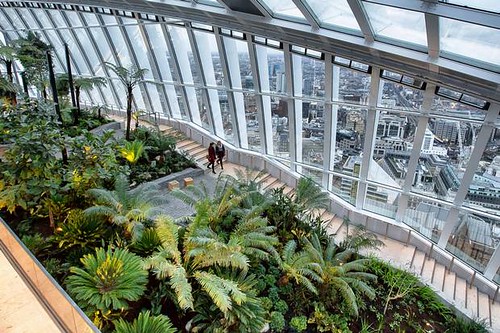Public access to building tops in the vertical city: cinemas, parks, and plazas
 House & Garden UK has a feature on "LONDON'S MUST-SEE LATE NIGHT EVENTS," and one of the items listed is the Rooftop Film Club, which screens films in four different places across London (they are planning a NYC operation as well).
House & Garden UK has a feature on "LONDON'S MUST-SEE LATE NIGHT EVENTS," and one of the items listed is the Rooftop Film Club, which screens films in four different places across London (they are planning a NYC operation as well).Many of the office buildings in DC's core do provide rooftop access to tenants as an amenity.
Some of the buildings provide access on 4th of July, to see the fireworks, which is pretty cool.
While I've written about how neat it is that the Salt Lake City Central Library's green roof and patio is open to the public and offers majestic views (Image at right from Utelitesoil).
The San Diego Central Library roof is open to the public and isn't so majestic as SLC but it is set up better for film presentation.
Showing movies on a library's downtown roof top would be an interesting extension of public access and use, given that most such access is otherwise privatized.
Image of the patio at the San Diego Central Library by Natalia Robert for Connect San Diego.
2. As part of receiving approvals to build a skyscraper at 20 Fenchurch, in London, the developer offered to construct and operate an indoor park on the top three stories of the building. See "Walkie Talkie park opens to public amid row over public access" from the London Evening Standard.
The space includes restaurants--one decidedly upscale offers a caviar plate for £325--but visitors are limited to 90-minute visits by timed appointment and must bring photo identification in order to get in the building.
The building, designed by starchitecct Rafael Viñoly, is 34 stories tall, and the fifth tallest in the city.

Sky Garden at the top of the "Walkie Talkie" building, London. Photo by Alex Lentati, for the London Evening Standard.
The building is notorious not just for its shape, which led to its nickname, but because concentrated light beams emanating from the glass curtain wall "melted" parts on a Jaguar parked on the street, so the building has been fitted with an awning to diffuse light bouncing from the building.
3. Separate is the issue of access to "privately owned public spaces" which have been created as part of planning approvals, usually in return for variances, density bonuses, etc.
There is a book about such spaces in New York City (Privately Owned Public Space: The New York City Experience), and awareness of the issue came to the fore during the Occupy Wall Street movement, because Zuccotti Park, home to the protests, is such a space.
In San Francisco, the San Francisco Planning and Urban Research Association has published a public access guide to such spaces there, Streets of San Francisco.
 4. SF' privately owned public spaces include rooftop plazas on a privately owned building, at One Kearny, pictured at right (Photo by Liz Hafalia, SF Chronicle), and the San Francisco Federal Building.
4. SF' privately owned public spaces include rooftop plazas on a privately owned building, at One Kearny, pictured at right (Photo by Liz Hafalia, SF Chronicle), and the San Francisco Federal Building. See "Privately owned public spaces: Guidance needed" from the San Francisco Chronicle.
SF's spaces came about as a result of the 1985 Downtown Plan, which called for 1 s.f. of public space for 50 s.f. of private space.
John King argues that it is time for the regulations to be updated, in part to deal with access issues, as many of the spaces, as pointed out by SPUR, are not promoted as being open to the public, as well as design issues, since many of the spaces aren't outfitted in ways that promote use, activation, and lingering.
 Photo: Liz Hafalia, The Chronicle. The 11th floor Skygarden in the Federal Building has a remarkable view of South of Market, but there's no sign announcing it on 7th Street and there's a security checkpoint at the building's entrance.
Photo: Liz Hafalia, The Chronicle. The 11th floor Skygarden in the Federal Building has a remarkable view of South of Market, but there's no sign announcing it on 7th Street and there's a security checkpoint at the building's entrance. I don't think that the SF Federal Building will start screening movies in its Skygarden, but it would be cool.
At least one of the House Office Buildings in DC has a nice terrace space overlooking Pennsylvania Avenue SE.
Labels: proffers, public realm framework, public space management, theater-cinema, urban design/placemaking, vertical city, vertical mixed use






0 Comments:
Post a Comment
<< Home